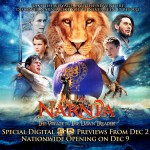
The film, directed by Michael Apted and starring Ben Barnes, Skandar Keynes, Georgie Henley and Will Poulter is the third film in the Chronicles of Narnia series, and is the industry’s biggest full 3D conversion film to date.
The opportunity to convert ‘The Chronicles of Narnia: Voyage of the Dawn Treader’ came in June 2010, when producers were looking for a facility that could manage such an extensive project in the challenging timeframe. With its integrated worldwide studios and global digital pipeline at the heart of the project, Prime Focus was able to convert a staggering 1500 shots into S3D for the 115-minute movie. Normally for a project of this magnitude, the studio would split up conversion shots between a number of vendors, but with artists working across its facilities in London, Los Angeles and Mumbai, Prime Focus was able to take ownership of the 3D conversion.
It was this global team mobilisation which ensured the high quality delivery of the project on time. Sean Santiago, Vice President, Visual Effects Walden Media emphasised how important this was: “We chose Prime Focus based primarily on their ability to deliver. In Prime Focus we recognised a toolset that when properly harnessed would result in high quality stereo images across an incredible volume of material.”
Prime Focus Film spent 24 hours a day across three different time zones working on the conversion process. In total they delivered 600 shots from London, 550 from Los Angeles and 350 from Mumbai.
Richard Baker, senior Prime Focus stereographer, emphasised that without the company’s global digital pipeline the process wouldn’t have run as smoothly. “Our long experience and huge knowledge base in the conversion arena, our production proven pipeline and the efficiency of our transfer technology gave us the ability to respond to client changes immediately. The client was amazed that we could view a shot in London, submit notes to Mumbai at the beginning of dailies and have the amended stereo 3D shots sent back for review before the end of the session.”
A very close working relationship with the Fox and Walden production teams, in particular the studio stereographer Ed Marsh, was essential to the success of this project. Prime Focus spent a great deal of time with Ed at the beginning of the process, developing and understanding the levels of depth required for different types of shot and developing a shorthand which helped the project to run efficiently. As Santiago explains, “Working with Prime Focus was a collaborative experience based on partnership. Every artist shared the same goal as our own team of filmmakers: render the best stereo material from single-camera photography possible. Thanks to Prime Focus’ tireless effort, that goal was achieved.”
One of the main challenges Prime Focus faced working on such a large and vfx-heavy project was dealing with the huge number of assets produced by the multiple vfx facilities working on the film. By producing a ‘vendor package’ book, detailing exactly how vfx material should be delivered for successful conversion, and by leveraging the good relationships Prime Focus holds with the various vfx vendors on the project, the company was able to effectively process and manage over 10,000 delivered assets to produce the 1500 S3D conversion shots.
Matthew Bristowe, senior producer at Prime Focus, praised the talent of the team of artists and stereographers for their work on the project. “Without our global infrastructure and such a committed team, we couldn’t have achieved the results we did. This project was delivered by the most highly- skilled stereo conversion team out there and we think the final results speak for themselves.”
Did you see it in 3D? What did you think of the 3D conversion? Personally, I thought it was the best 3D conversion that I have ever seen. It gives the screen a lot of depth. I think it was a successful conversion to 3D, especially considering some other films I had seen converted in post.
